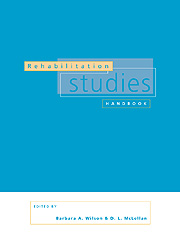Book contents
- Frontmatter
- Contents
- List of contributors
- 1 Introduction to rehabilitation
- 2 Disabled people in society
- 3 Disability equality training
- 4 Towards a therapeutic alliance model of rehabilitation
- 5 Rehabilitation education: a learner-centred approach
- 6 Work, occupation and disability
- 7 Management in rehabilitation
- 8 Research and evaluation in rehabilitation
- 9 Statistical methods
- 10 Social policy, disability and rehabilitation
- 11 Principles of the acquisition of sensorimotor skills
- 12 Management of acquired cognitive disorders
- 13 Challenging behaviour: helping people with severe brain damage
- 14 Pain
- 15 The multiply handicapped child
- 16 The transition to adult life
- 17 Factors specific to disabled elderly people
- Index
17 - Factors specific to disabled elderly people
Published online by Cambridge University Press: 06 November 2009
- Frontmatter
- Contents
- List of contributors
- 1 Introduction to rehabilitation
- 2 Disabled people in society
- 3 Disability equality training
- 4 Towards a therapeutic alliance model of rehabilitation
- 5 Rehabilitation education: a learner-centred approach
- 6 Work, occupation and disability
- 7 Management in rehabilitation
- 8 Research and evaluation in rehabilitation
- 9 Statistical methods
- 10 Social policy, disability and rehabilitation
- 11 Principles of the acquisition of sensorimotor skills
- 12 Management of acquired cognitive disorders
- 13 Challenging behaviour: helping people with severe brain damage
- 14 Pain
- 15 The multiply handicapped child
- 16 The transition to adult life
- 17 Factors specific to disabled elderly people
- Index
Summary
Introduction
Throughout the world, populations are ageing rapidly. Elderly people experience not only a decline in physiological function, but they are also more prone to a range of diseases. In developed countries older people already comprise the majority of those who suffer from disability, and developing countries are set to face a similar challenge in years to come. This chapter explores the effects of ageing on populations and individuals, some of the key age-related diseases such as stroke, dementia and hip fracture, and how services may be organised to cope with ensuing disabilities.
Ageing populations
Until recent times, great old age in human populations was a relative rarity. Families were large, and deaths in infancy, childhood and early adulthood were commonplace. Most people spent the whole of their lives rooted to the environment into which they were born, so that those few who survived into old age could rely on a strong network of support. The role of the extended family was paramount, the passing of knowledge from one generation to another relied largely on the spoken word, and so elders could claim pride of place within their communities. In terms of the history of the human race, the situation has changed with extraordinary speed.
Following the industrial revolution in Western countries, improvements in housing sanitation, nutrition, education and the like led to a gradual reduction in premature deaths. Figure 17.1 shows ‘survival curves’ for the population in England in the years 1901, 1946 and 1975. It can be seen that in 1901, 25% of people died before reaching their mid-twenties (largely from infectious diseases), and only half the population reached their late fifties.
- Type
- Chapter
- Information
- Rehabilitation Studies Handbook , pp. 379 - 404Publisher: Cambridge University PressPrint publication year: 1997



